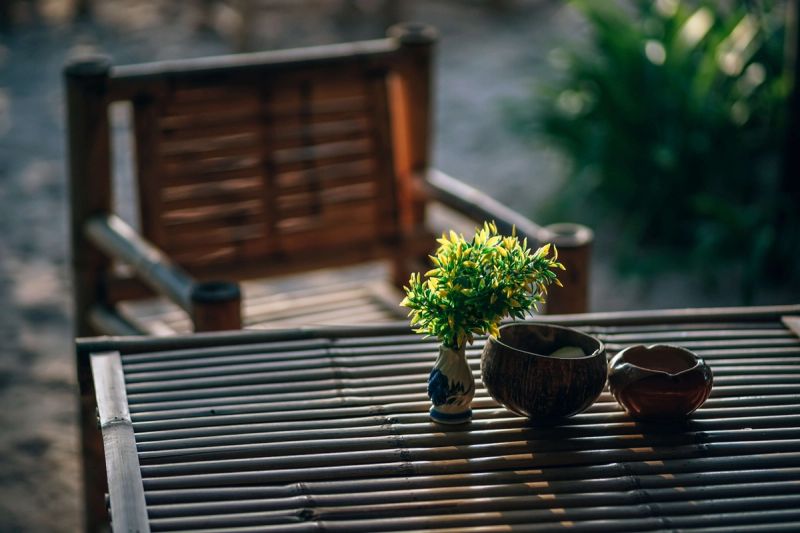How to protect garden furniture in winter
From sofas sets to dining tables and chairs: keep your outdoor furniture in tip-top condition with these simple tricks and it’ll last you for years to come.
It pays to care for your garden furniture all year round, but it’s most important to protect outdoor dining sets, garden sofas and firepits over the winter when rain, storms and snow can come lashing down without warning.
There are three courses of action:
- Store your furniture undercover
- Cover it up
- Leave it as it is.
Storing garden furniture undercover
Most tables, chairs and benches are weather-resistant and will survive the odd shower. During autumn and winter, as the weather becomes less…clement, metal, rattan and wooden garden furniture will do better with a roof over their heads.
Wondering where to store your garden furniture? A watertight shed or garage are the ideal places to store outdoor furniture when it’s not in use. These spaces will keep it dry and out of the elements, preventing rot and rust.
If you have a balcony or small space garden, you might be able to find a space in the loft or in the under-the-stairs tardis cupboard for your bistro set or summer sun loungers.
Before you fold up the outdoor table, stack away the patio chairs, and carry off the chiminea, make sure they’re clean and dry or the lack of good air circulation might lead to decay.
Covering outdoor furniture up
Of course, not everyone has the luxury of space and you may not have room to store garden furniture indoors.
But the good news is, with a bit of prep, you can leave the sofa out on the terrace, let the garden bench stay put and the balcony armchair live to seat another day.
The best thing to do is to invest in garden furniture covers, especially if you have rattan tables or seating. Some manufacturers make bespoke covers for particular furniture sets, but you can also buy large rectangular covers and tarpaulins that will do the job. There are covers for corner sofas, benches, parasols and dining sets. Some outdoor fireplaces (like the Henley) have specially designed covers, too. Think of it as a rain mac for your furniture. (No need to put wellies on the chair legs, though.)
Can I leave my garden furniture uncovered all winter?
If you’re planning on leaving metal or hardwood outdoor furniture uncovered, it’s really not the end of the world.
If you can, try to shift it into a protected spot where strong winds can’t blow it over. If wooden furniture is on a lawn, move it onto a hard surface if possible, or raise it off the ground using slabs or bricks, so damp can’t rise up through the legs.
Be sure to show uncovered furniture some love and affection come the spring to ensure it doesn’t deteriorate.

Year-round garden furniture protection
Whether your tables and chairs have been sitting inside for the winter or your bench or sofa set has spent the cold, wet months outdoors, it’s a good idea to spruce things up each spring and keep them clean throughout the year.
Caring for garden furniture is pretty straightforward. Rid wooden garden furniture of patchy-looking lichen by giving it a scrub with soapy water and a stiff brush. And treat it to a coat or two of wood oil or stain on an annual basis to keep yourself sitting pretty for years to come.
Pounce on synthetic rattan, plastic and metal furniture with soapy water and a cloth to smarten it up as needed. If the metal frames get scratched, they might need a scrub with steel wool and a daub of metal paint to offer protection against rust.
If legs or table tops are feeling rickety, dig out the screwdriver and tighten everything up to make sure it stays strong and up to the task.
Caring for garden chair cushions
After a long season of outdoor living, your garden chair cushions might be in need of some attention, too. Keeping garden cushions clean throughout the year is a good way to ensure they stay looking their best.
Before you stash them away for the winter, tackle spillages and mould. Either spot wash them by hand or, if the covers are removable, unzip them and throw them into the washing machine on a gentle cycle. Let them air dry thoroughly before bundling them up or the inner pillows might start to sprout mildew.
If you can, try to store your garden cushions indoors over winter, so mice aren’t tempted to take up residence in their cosy stuffing. If there’s no room in the house, keep them in a secure box in the shed or garage.
Garden umbrellas and parasols should also be cleaned and stored somewhere dry over the cooler months.
How do I protect my pots and planters over winter?
It’s not just tables and chairs that need protection when the weather turns murky. Looking after plant pots is important, too. Wash out any unused pots and let them dry before stacking them, to keep nasty diseases at bay and make sure they’re safe and sound. If you’re leaving planters outdoors all year round, raise them up on pot feet or bricks to make sure excess water can drain easily. If you’re worried about frost damage, consider moving them into a greenhouse or conservatory during the cooler months.